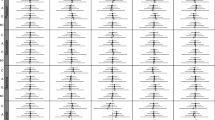Abstract
A multiple regression model for the analysis of twin data is described in which a cotwin's score is predicted from a proband's score and the coefficient of relationship (R=1.0 and 0.5 for identical and fraternal twin pairs, respectively). This model is especially appropriate for the analysis of data on twins in which one member of each pair has been selected because of a deviant score, e.g., low reading performance. When the model is fitted to such data, the partial regression of the cotwin's score on the coefficient of relationship provides a powerful test of the extent to which the difference between the mean for probands and that for the unselected population is heritable, i.e., a test for genetic etiology. By fitting an augmented model containing an interaction term to either selected or unselected data sets, direct estimates of heritability and the proportion of variance due to shared environmental influences can also be obtained (subject, of course, to the usual assumptions underlying twin analyses, e.g., a linear polygenic model, little or no assortative mating, and equal shared environmental influences for identical and fraternal twins).
Similar content being viewed by others
References
Cohen, J., and Cohen, P. (1975).Applied Multiple Regression/Correlation Analysis for the Behavioral Sciences, Lawrence Erlbaum Associates, Hillsdale, N.J.
Decker, S. N., and Vandenberg, S. G. (1985). Colorado Twin Study of Reading Disability. In Gray, D., and Kavanagh, J. (eds.),Biobehavioral Measures of Dyslexia, York Press, Parkton, Md. (in press).
DeFries, J. C. (1985). Colorado Reading Project. In Gray, D., and Kavanagh, J. (eds.),Biobehavioral Measures of Dyslexia, York Press, Parkton, Md. (in press).
Dunn, L. M., and Markwardt, F. C. (1970).Examiner's Manual: Peabody Individual Achievement Test, American Guidance Service, Circle Pines, Minn.
Fulker, D. W. (1981). The genetic and environmental architecture of psychoticism, extraversion, and neuroticism. In Eysenck, H. J. (ed.),A Model for Personality, Springer-Verlag, New York.
Ho, H.-Z., Foch, T. T., and Plomin, R. (1980). Developmental stability of the relative influence of genes and environment on specific cognitive abilities during childhood.Dev. Psychol. 16:340–346.
Morton, N. E. (1982).Outline of Genetic Epidemiology, Karger, New York.
Rose, R. J., and Ditto, W. B. (1983). A developmental-genetic analysis of common fears from early adolescence to early adulthood.Child Dev. 54:361–368.
Wilkinson, L. (1984).SYSTAT: The System for Statistics. SYSTAT, Evanston, Ill
Author information
Authors and Affiliations
Additional information
This work was supported in part by a program project grant from the NICHD (HD-11681).
Rights and permissions
About this article
Cite this article
DeFries, J.C., Fulker, D.W. Multiple regression analysis of twin data. Behav Genet 15, 467–473 (1985). https://doi.org/10.1007/BF01066239
Received:
Accepted:
Issue Date:
DOI: https://doi.org/10.1007/BF01066239




